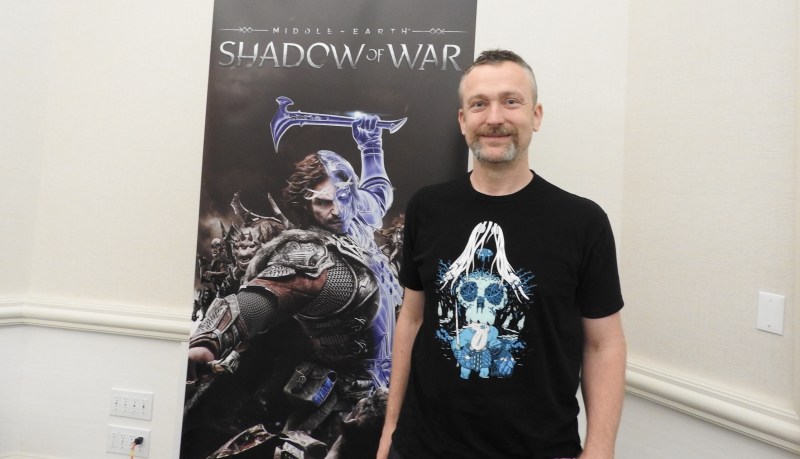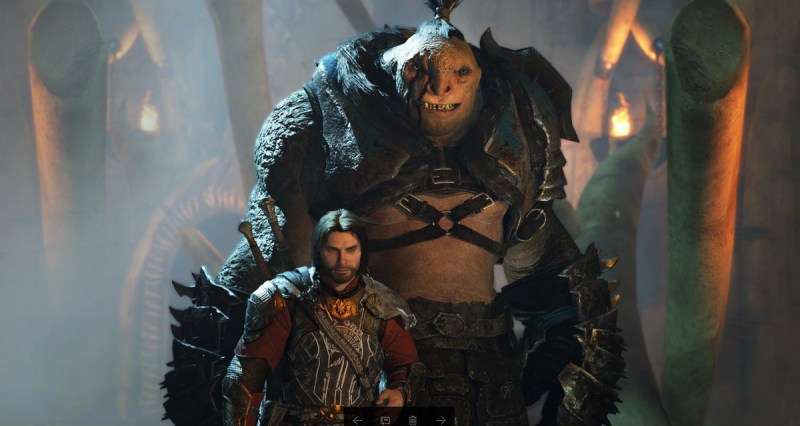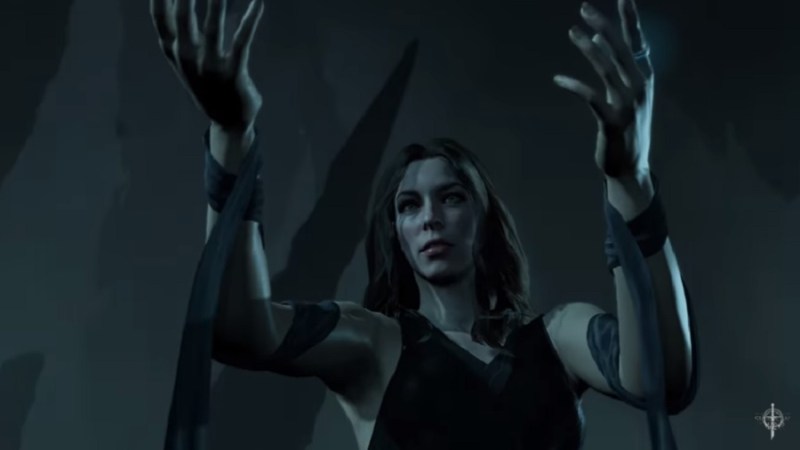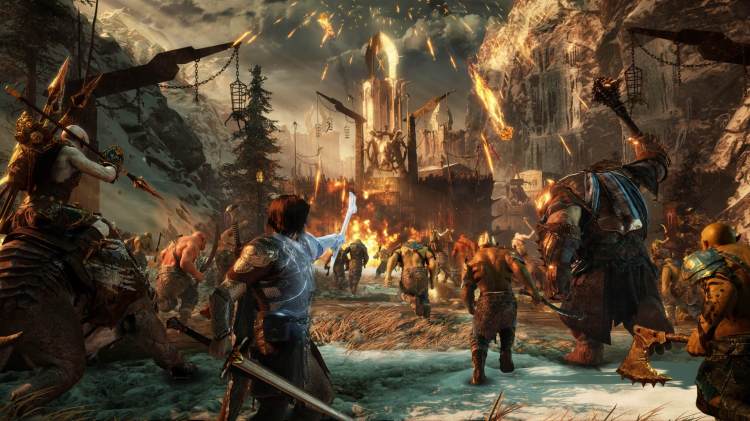Middle-earth: Shadow of War is one of the biggest games of the fall, and it made a big splash when it debuted on October 10 on consoles and PC.
To Tolkien geeks, this is all we have. Peter Jackson isn’t making any more movies. So we played our hearts out. I played all 63 missions in the campaign and saw both of the endings that the game includes.
And now we’ve done a postmortem interview about making the massive open-world game with Michael de Plater, the creative director at Monolith Productions, the Warner Bros. Interactive Entertainment studio that created Shadow of War, as well as its predecessor, Middle-earth: Shadow of Mordor.
The second title in the series to be set in the fantasy world of J.R.R. Tolkien’s The Lord of the Rings, Shadow of War carries on an original story where you play Talion, a Ranger who has become the Bright Lord. He challenges Sauron, the Dark Lord, for the throne of Mordor. The story takes place in the 60 years between the events of The Hobbit and The Lord of the Rings.
June 5th: The AI Audit in NYC
Join us next week in NYC to engage with top executive leaders, delving into strategies for auditing AI models to ensure fairness, optimal performance, and ethical compliance across diverse organizations. Secure your attendance for this exclusive invite-only event.
This interview has narrative spoilers — Ed.
We marshaled GamesBeat’s knowledge of Tolkien lore and asked de Plater a couple of tough questions. He managed to save his cred on a question about Celebrimbor, but we got him on the anachronism of an Uruk appearing in the Second Age. (OK, only Tolkien nerds care about this stuff.) We talked with de Plater about the multiple endings, the challenge of living up to the Tolkien legacy, and how Monolith has stretched is creativity and built an adaptation of Middle-earth for modern gamers.
Here’s an edited transcript of our interview.

Above: Michael de Plater, director of Middle-earth: Shadow of War.
GamesBeat: What’s it been like, being the steward of the series?
Michael de Plater: It’s been absolutely incredible so far. We’ve been working on this for six years now. You get really close to the game and to the universe of Middle-Earth and to all the people you’re working with. It’s a roller coaster. It’s so satisfying, after that six years, to have Shadow of War out. In a lot of ways it’s the fulfillment of a lot of the ideas and goals we had at the inception of Shadow of Mordor. Especially in terms of realizing the epic scale and trying to evoke some of the grandeur, to have something that meaningfully ties into the Lord of the Rings. Shadow of Mordor, we were a lot more limited in scope, in our ability to be ambitious, compared to this game.
Six years are a long time. It’s a big chunk of people’s lives. You work alongside people who are growing and learning and bonding and having kids. It’s a pretty intense experience.
GamesBeat: What’s the feedback been like this week?
de Plater: It’s been exhilarating. The thing that’s exciting is seeing people’s personal stories. The nemesis stories have been amazing. There were some little details and surprises we put in the nemesis system, and sometimes, whether it was a writer or an artist—they’d say, “Is it really worth putting this in? Do we really believe anybody will ever see this?” And here we are three days later and people are discovering all sorts of stories and details. It’s removed any doubt or regret we could have had. It was worth putting in as much attention and as much focus and as many stories as possible.
The other thing that’s been wonderful, maybe the most exciting thing, is seeing people writing stories about how emotionally affected they are by the nemesis system. It’s making people think and feel about their relationship to these orcs and the consequences of using the Ring. It’s dominating them, compelling them to join, shaming them, casting them out, killing them. People have genuinely strong emotions about those stories because they’re personal stories. Looking at reviews and seeing the scope of that—it’s so much bigger than the reaction on Shadow of Mordor at the same time.
It’s also because social media and things like Twitter have evolved so much. It’s easier for us to get involved in that conversation and see what people are saying and embrace that.

Above: A man and his troll.
GamesBeat: It’s an interesting perspective. I’ve said that some of this game is quite a grind. Some people are describing fighting battles in the same places against some of the same orcs as a grind. But your Nemesis system makes it unique. You’re coming back to these characters, but they’re different. Maybe you kill them once, and then they’re back as undead. It creates that emotional attachment. I was sad when I lost one of the captains I’d been with for a long time.
de Plater: It’s been interesting to watch. We came out, what, Tuesday? It’s been about four days. In some ways the game is at its best when it’s not just rapidly consumed, because there’s a lot of game there, whether it’s 50 or 60 or whatever hours. People are going to build stories over time, and I think the game is really going to shine when people enjoy it like that. Because of the way we’re supporting it, with new tribes and new campaigns and new nemesis stuff, people should be able to love it for a long time.
GamesBeat: In Shadow of Mordor, I almost quit the game because I kept failing and making the orc captains I fought stronger. I got to a point where I almost couldn’t beat them anymore. The way you level up here, is there a risk of that still happening, or have you changed that in some way?
de Plater: A massive amount of our effort and focus this time was on balancing. In some ways, it isn’t as immediately noticeable, but it was a huge amount of work. We balanced the orcs and their traits. We wanted them to be more varied and more challenging, but also not impossible.
We created all the different advanced classes, so they have a less random combination of traits. In Shadow of Mordor sometimes you hit an unlucky combination of dice rolls that meant a particular orc had traits that made him invincible to most things. Now it’s less arbitrary. There’s still a lot of variation, though, because of their hates and fears and classes and tribes. On the other side, we expanded Talion and Celebrimbor’s abilities a lot. There’s a lot more customization, especially with the gear system. Even if someone does have what seems to be an almost impossible combination of traits, there are more ways you have to take him down.
On top of that, we added the difficulty modes. That’s another thing we’ve really enjoyed since release. Some players have absolutely loved the nemesis difficulty. In some ways the game is at its best when it’s creating these stories around players getting defeated and dying. On the other hand we added the easy difficulty mode, so if people do want more of a walk into Mordor, they can have that as well.
The combination and complexity and all the systems we’ve expanded that interact with each other was a major part of our focus this time. We had a combination, of course, of designers and people who had experience from Shadow of Mordor, but we also brought in some great talented new people as well, working specifically on that challenge.

Above: Shelob tempts Talion in Middle-earth: Shadow of War.
GamesBeat: I’m very happy to be able to interview now after I know what the story is about. I’ve seen the ending, and the true ending as well. Can you talk more about what sort of story you wanted to tell?
de Plater: There were a few goals with the story. One was to hit upon and evoke some of the most iconic and epic elements of the Lord of the Rings and the Hobbit. We thought about Helm’s Deep, or meeting Galadriel. We wanted to resonate with some of those iconic moments from the books and the films, and find a way to weave those in authentically with the nemesis system and the setting in Mordor and Talion and Celebrimbor’s story.
We knew we wanted the player’s goal within the nemesis system to be the conquest of Mordor. We needed to find a story and context and characters that bordered that. The nemesis system didn’t feel as detached from what we call the golden path, the main story.
Something that happened with Shadow of Mordor—we felt some people missed the themes or intention of the game, what we were trying to say about Talion and Celebrimbor’s use of power and the dangers of that. It was sometimes interpreted as a mindless hack and slash, like we’d failed to communicate that we were presenting the stakes and the risks and the dangers of what they were doing. We made a lot more effort to be coherent and consistent in communicating what those themes were – death, undeath, domination, and Sauron’s goals.
One thing that did feel successful in Shadow of Mordor was showing Sauron from another point of view, and his relationship with Celebrimbor. We wanted to show that the villains in Lord of the Rings were the result of some sort of fall. Everyone sets out with positive intentions, but they can be twisted by the pursuit of power, even power over death itself.
GamesBeat: Should people think of this as an alternate universe or one that’s consistent with the rest of the lore? Did you make some decisions about whether to completely follow the lore or to modify it in some ways?
de Plater: People should think of it as an adaptation. There are things we do relative to the timelines in the books, for example. We brought up the fall of Minas Ithil. We wanted to use Helm Hammerhand. In the books he’s a spirit of vengeance, and we wanted to tie that to the narratives of the Ringwraiths – someone whose story of pursuing revenge and falling and becoming a Nazgul resonated with Talion. We were taking the intention, the spirit, and the themes of the books, but adapting them to fit within a slightly different timeline and story.
It’s an adaptation, basically. If you see almost any film or TV show or other work coming from a canon book or other original property, that’s often the best way to approach that. We’re as faithful as we can and as true as we can to everything we love and feel is in the spirit of Middle-Earth, but it’s certainly our version of a lot of those elements. It has that focus on, perhaps, the darker side of Tolkien’s works. It’s exploring the areas where there is more ambiguity.
It’s a kind of what-if in some ways. When you read Lord of the Rings, the big question that gets posed more than any other is what would happen if someone with power took up the One Ring. Gandalf is tempted. Galadriel is tempted. Boromir is tempted. Celebrimbor is our answer, in some ways, to what would have happened if Galadriel had taken the Ring and become a dark queen in place of a dark lord. Or what would it have looked like if Saruman had taken the One Ring and used his army of Uruk-Hai to challenge Sauron? Talion is a bit more like if Boromir had gotten the Ring.
We’re trying to be very authentic to the spirit of the books, but as I say, it does deviate somewhat from the timeline and the canon. So do the movies. They have deviations that are in some ways quite significant, like removing the scouring of the Shire. That’s quite a big change. So these are all different timelines in some ways.

Above: Shadow of War is about taking over enemy fortresses.
GamesBeat: There are a few differences I saw. Celebrimbor leads the armies against Sauron, instead of Gil-galad?
de Plater: In our timeline that actually takes place before the Last Alliance. But what we did add in Shadow of Mordor was the notion that when Sauron first forged the One Ring, it was this blazing object of power that drew everyone’s attention, and because he worked with Celebrimbor on the forging of the other rings, he went to Eregion and dragged him back to Mordor and forced Celebrimbor to perfect the One Ring and inscribe the script on it, which gave it those powers of subtlety and invisibility that helped it hide, from Sauron and everyone else.
In that moment of forging the One Ring Celebrimbor stole it, raised an army, and had this first war for Mordor using the Ring to dominate the orcs and challenge Sauron. It’s a bit of a prelude to the story we’re telling now in the Third Age.
GamesBeat: So that’s a case of addition to the lore.
de Plater: Right. It’s an addition that’s very consistent with the addition that Celebrimbor and Talion are reliving now in the Third Age. That’s another element that we take from Tolkien – the idea that these myths and stories recur. In this game, the relationship between Shelob and Sauron and their conspiring together is a recurrence of Ungoliant’s story conspiring with Morgoth in the First Age. These stories recur and repeat themselves in the manner of myths.
GamesBeat: Uruks were something that somebody brought up, that the Uruk-Hai were created in the Third Age. They seem to show up in the Second Age here. Was that a change in the canon?
de Plater: That really is just more of a continuity error as a result of production realities. We put a lot of effort into creating our Uruk-Hai. But that’s well-spotted.
GamesBeat: Eltariel — what was the thinking about bringing her in? She continues this theme of being tempted by the Ring.
de Plater: She is tempted by the ring, but she doesn’t succumb to that temptation. She’s this agent of Galadriel. We wanted to have the idea that the Nazgul are immortal in the way that they can be defeated and killed, but they’re always going to return. Which in some ways mirrors what’s happening with Talion and his story. We imagined someone who’s fighting this endless war against the Nazgul and never giving in to despair. Even though she has to fight them and defeat them and they’re always going to return—she’s bound on the wheel of that endless cycle.
That comes up very much in Tolkien, where Frodo and Sam are venturing into Mordor. They’re not determined because they have an expectation of victory. They’re doing it because they need to do it, because they have this sense of being duty-bound to do the right thing in spite of the fact that they can’t see a victory in it. We wanted Eltariel to epitomize that idea. A lot of the characters exist in some sort of thematic relation to Talion.

Above: The GamesBeat team fights about who is the biggest Shadow of War fan.
GamesBeat: I was curious about the structure of spreading the main narrative across multiple campaigns or locations but not continuing it through the siege battles. Some players feel like you have one ending happen, but then this true ending is behind a long period of grinding through the fortress battles.
de Plater: It’s interesting, that interpretation. We didn’t really think of the final ending as the “true” ending. We saw it as a bonus ending. Our reference point initially was the extra credits sequence you get at the end of a superhero movie, or in Arkham Knight where you get the Knightfall ending if you do all of the Riddler trophies. Not many people actually do that. So we really thought of it as a bonus ending in that way.
At the same time, one of the things that we learned from Shadow of Mordor was that people loved the nemesis system, but after the completion of the story, there weren’t any more goals or anything to do. We had players going through the story, building their fortresses, building their armies, and we didn’t want to do that again like we did in Shadow of Mordor. We wanted to make sure we continued to give people goals and enabled them to keep playing and defending those fortresses.
In hindsight we maybe could have used the UI to present it more clearly or make it feel a bit more like a different mode. But I don’t think we quite expected people to view those two elements together in a way where they saw it as a negative.
Having said that, one of the biggest comments I’ve seen on Steam is people saying they’ve gotten all the way through to the end of Shadow of War and then they can’t continue doing defense missions endlessly. In a way I have more sympathy for that point of view. We need to get in there and fix that and make sure people can continue to play those missions and have more of them. What’s grindy to some people, I guess, is just continuing to have fun with the nemesis system and forts and battles for other people.

